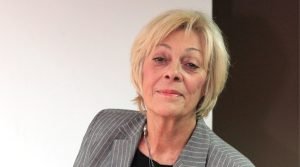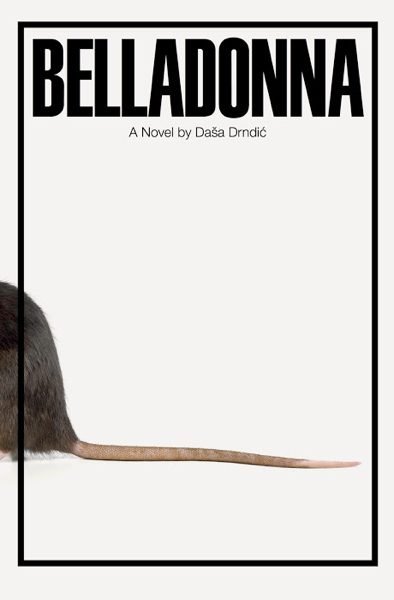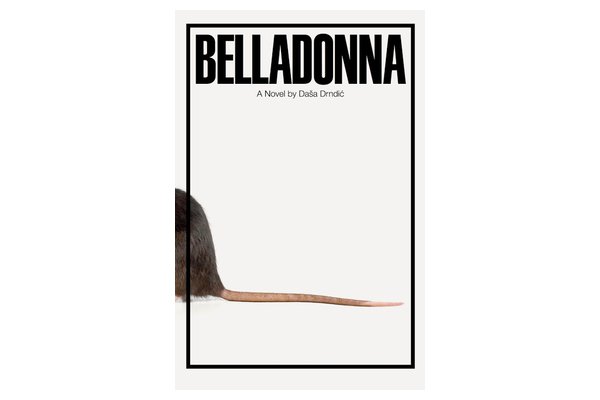A Look at Indie Authors and Their Publishers
By Lanie Tankard, Indie Book Reviews Editor

Book: Belladonna
New York: New Directions, October 31, 2017. 400pp., $19.95, paperback ISBN: 9780811227216, e-book ISBN: 9780811227223.
Author: Daša Drndić
Croatian novelist, playwright, literary critic, and translator Daša Drndić is a member of the Faculty of Philosophy at the University of Rijeka, where she earned her PhD on the subject of photofeminism. Born in Zagreb, she obtained a master’s degree in theater and communications from Southern Illinois University under the Fulbright Program, and was a visiting scholar at Case Western Reserve University in Ohio. She wrote and produced radio plays in the drama department of Radio Belgrade, and has also worked in publishing and taught in Canada.
She has been Laureat of the Independent Foreign Fiction Reader’s Prize and 2012 Writer in Residence at Association KROKODIL in Belgrade.

Drndić’s books include the novel Sonnenschein, published originally in Croatian in 2007 and translated into a number of languages—including the English Trieste in 2014. Another novel, Leica Format, is also available in English.
Translator: Celia Hawkesworth
Celia Hawkesworth, who translated Belladonna into English from Croatian, is senior lecturer emerita in Serbian and Croatian at the School of Slavonic and East European Studies of University College, London. She has written a number of books on the languages, literature, history, and cities of the Balkans. Her translated books include several by Dubravka Ugrešić and Ivo Žanić.
Publisher: New Directions
James Laughlin (1914–1997) founded New Directions in 1936 as a twenty-two-year-old Harvard sophomore working out of his aunt’s cottage in Connecticut. Before entering Harvard, Laughlin had studied at the Choate School with Dudley Fitts. When on leave from Harvard in Europe, Laughlin studied with Gertrude Stein in France and then ran into Ezra Pound in Italy. Pound gave him private tutoring lessons but after reading Laughlin’s poems for months, he “ruled them hopeless,” Laughlin recalled. So Laughlin sought career advice from the poet, who suggested he finish college and become a publisher.
Consequently Laughlin began New Directions with his own money from his father (a Pittsburgh steelmaker), “publishing quality works with little regard to their chances for commercial success,” according to the Poetry Foundation. He began with the first annual anthology of experimental writing, New Directions in Prose & Poetry, followed by plays, novels, and poetry collections.
Laughlin’s own poetry has been published in a number of books, including Phantoms and Country Roads. In 1954, the Academy of American Poets created the James Laughlin Award in his honor “to recognize and support a second book of poetry forthcoming in the next calendar year” by a poet. Laughlin received the National Book Foundation Medal for Distinguished Contribution to American Letters in 1992.
 Barbara Epler, president of New Directions, began as an editorial assistant there after graduating from Harvard in 1984. She moved up to associate editor, editor, senior editor, managing editor, editor-in-chief, vice president, publisher, and ultimately president in 2011. In a 2016 Asymptote interview, Epler said New Directions publishes “about thirty-five to forty new books a year.” She received the 2017 Friedrich Ulfers Prize from the Festival Neue Literatur, the 2016 Ottaway Award for the Promotion of International Literature from Words Without Borders, and the 2015 Editor’s Prize from Poets & Writers. Epler has served as a judge for the PEN/Heim Translation Fund Awards.
Barbara Epler, president of New Directions, began as an editorial assistant there after graduating from Harvard in 1984. She moved up to associate editor, editor, senior editor, managing editor, editor-in-chief, vice president, publisher, and ultimately president in 2011. In a 2016 Asymptote interview, Epler said New Directions publishes “about thirty-five to forty new books a year.” She received the 2017 Friedrich Ulfers Prize from the Festival Neue Literatur, the 2016 Ottaway Award for the Promotion of International Literature from Words Without Borders, and the 2015 Editor’s Prize from Poets & Writers. Epler has served as a judge for the PEN/Heim Translation Fund Awards.
Laurie Callahan, New Directions’s executive vice president, is a native of Cleveland. She moved to New York City after graduation from the former Western College for Women in Oxford, Ohio.
Declan Spring is vice president, senior editor, and director of foreign rights at New Directions. He holds an MA in English from New York University.
New Directions does not accept unsolicited manuscripts, but “will make an effort to answer all brief queries.” The submissions policy is on the website.

Review:
Here is Belladonna, the Lady of the Rocks,
The lady of situations.”
—T.S. Eliot
“The Waste Land” (For Ezra Pound)
Do not start reading Belladonna under the assumption you are entering a normal novel. Be ready to don the mind of protagonist Andreas Ban as you help him sift through facts in his memory research. Andreas Ban encounters a number of situations in need of rumination, so ruminate he does—often at length—in Croatian author Daša Drndić’s novel Belladonna.
Sixty-five-year-old Andreas Ban, a retired psychologist living in a small coastal Croatian town, confronts breast cancer—extremely rare in men. Next comes a broken arm, underscoring Shakespeare’s observation spoken by Claudius in Hamlet: “When sorrows come, they come not single spies, but in battalions.”
Andreas Ban is clearing out not only the metaphorical muddle in his mind but also the literal clutter of possessions in his apartment of twenty years. What to keep? Perhaps a “little china shoe” from his deceased mother? A “miniature antique grandfather clock” from his adult son, Leo? A photo of his late wife, Elvira? Hmmm, and what to toss out the window—perhaps some of his former experiences?
Andreas Ban, a Croat, has lived in Paris, Belgrade (Serbia’s capital since 2006, Yugoslavia’s before), Skopje (Macedonia), and Rijeka (Croatia). Now, invited back to Belgrade after two decades, he declares in a letter to Leo: “I’m going to get my life back.”
Drndić cleverly employs icons resembling apertures as quotation marks around memories that pop into Andreas Ban’s head as he strolls his former city. Because a hole’s size determines the amount of light that enters, Drndić places a wider aperture at paragraph beginnings—thus creating a visual symbol representing the pupils of Andreas Ban’s eyes, which open whenever a Belgrade image hits his brain and brings back a memory. Drndić employs tinier apertures at paragraph endings as recollections fade.
Andreas Ban, who had written for newspapers in Belgrade, was called an enemy of the state when Leo was eight. A colleague of Andreas Ban told him his face didn’t look Serbian. “It’s good you’re going,” she added. After Andreas and Leo Ban move from Serbia, Leo’s new classmates in Croatia wonder whether his last name is Serbian or Croatian, for such distinctions mattered.
Leaving no stone unturned, Andreas Ban reconciles past with present, history with remembrance, fact with fiction. He studies his fellow bus passengers. He observes patients in doctors’ waiting rooms. Starting with World War II and Yugoslavia’s disintegration, he delves into topics as diverse as biometric techniques, grief stages, his needle-core biopsy, oil extraction and genocide in Nigeria, lipstick’s value to women in cancer hospitals, cancer’s nomenclature, Bergen-Belsen concentration camp’s 1945 liberation, oncology’s progress, sentinel nodes and the etymology of sentinel, eugenics, and a Dutch TV show about cooking with purslane.
Drndić titles her novel after another plant that wears many hats—medicinal, cosmetic, and poisonous. Also called “deadly nightshade,” the A. belladonna bush bears toxic black berries. Both the berries and the leaves produce a rash when touched, unconsciousness when consumed, and usually death. Shakespeare’s Juliet is thought to have consumed it. Belladonna contains atropine and scopolamine. Atropine takes its name from the plant’s genus, Atropa, which in turn is named after the goddess Atropos in Greek mythology. As one of the three Moirai (or Fates) who decided a person’s destiny, Atropos determined exactly how each would die—a topic Andreas Ban contemplates in Drndić’s book as he wrestles with Atropos to control his own future.
The word belladonna translates from Italian into “beautiful lady” because women in sixteenth-century Italy used this bush to dilate their pupils and appear more alluring. Perhaps Drndić intends it as a metaphor as Andreas Ban opens his eyes to reality. “Andreas Ban no longer knows what to think,” she writes. Leo works to reconstruct his father’s life. Drndić certainly works to open her readers’ eyes to past situations with present repercussions.
One never knows what might appear on the next page. Will it be words, photographs, poetry, musical compositions, a moth—or perhaps a detailed drawing of an ear’s acupuncture points morphing into ears on passport photos? In 1941, more than a thousand Šabac Jewish refugees are killed during the Holocaust and put in a mass grave at Zasavica in Serbia. Four years later, their remains are taken to the Šabac Jewish Cemetery. In another fourteen years, they’re transferred to the Sephardic Cemetery in Belgrade, so they may they rest in peace. Drndić devotes over a dozen pages of Belladonna to listing each name.
Daša Drndić also works in one of her previous books, Trieste—giving its protagonist (Haya Tedeschi) a walk-on role in Belladonna. Andreas Ban reads Trieste and then discusses that novel in this novel. It’s a fascinating fiction technique. Might we call Andreas Ban a metaprotagonist?
Drndić follows no pattern here. She innovates as she imagines. Belladonna is rife with factual research, quotations, editorial opinion, photos, and everything but the kitchen sink. Drndić masterfully transfers the art of pharmacy compounding to fiction, mixing a potent novel á la W.G. Sebald seasoned with Primo Levi. Drndić’s staccato drumbeat voice conveys urgency. Her unique sentence structure includes one that’s 219 words long. Her voice arrests: “But he is not sad, Andreas Ban. I am not sad, he says.” Andreas Ban comes to believe that poetry is the repository of memories.
Silence, remembering, forgetting—these are the touchstones Drndić employs throughout. “Remembering is best done in old age,” Andreas Ban thinks, weighing the merits (“life is calmer then”) against the disadvantages (“memories become deceptive, distorted”). Have they ever been real? “Family secrets surface unexpectedly and too late.” Occasionally Andreas Ban becomes Daša Drndić’s alter ego, as certain experiences of his life resemble those of hers.
I begin chuckling when Andreas Ban gets lost wandering Amsterdam in search of a large Albert Heijn, the old Dutch supermarket chain. He spots Croatian author Dubravka Ugrešić across the street. “Straightaway he asks her, Dubravka, is there a larger AH in the neighborhood? and she says, I don’t know.” Drndić writes stream of consciousness while retaining plot control.
She definitely minces no words when describing past events—eviscerating academia while bringing in Walter Benjamin, Albrecht Dürer, Josef Mengele (the “Angel of Death”) and his seven dwarfs (who speak of their treatment here), Anton van Leeuwenhoek, Alfred Eisenstaedt, Mrs. Dalloway, Dutch historian Frank van Vree, and George Gershwin, among many. “Oh, and here comes…”, she’ll write.
In Andreas Ban’s head, Søren Kierkegaard and Franz Kafka debate the worth of writing. Andreas Ban can’t get their voices to stop. Drndić spends a number of pages taking Sigmund Freud to task for his treatment of Bertha Pappenheim, “whom Freud deprives of her name,” calling her Anna O. instead. Drndić includes the 1954 postage stamp Germany dedicated to Pappenheim.
As Drndić skewers “a deaf age of defiled silence,” she seems to ask: Do children bear the sins of their fathers? She notices the offspring of Nazi war criminals who seek out concentration camp victims to beg forgiveness. “I am not like him,” they repeat, almost more to convince themselves than those who survived. Drndić segues from historical discussions to philosophical considerations of morality, overlaid with ongoing explicit descriptions of bodily functions. She addresses melancholia, a pathological form of grief exhibiting as depression. Readers shiver as she illuminates the Netherlands winter that was so cold and the Dutch were so hungry they ate tulip bulbs, and yet still 30,000 died. She considers whether the memory of such collective trauma engraves itself within genetic code and transforms into a national archetype.
One encounters sentences that call for rereading, so lush are they with symbolism. Some paragraphs simply take your breath away with their power. Drndić devotes several delicious pages to bookstores when Andreas Ban visits the Athenaeum Boekhandel in Amsterdam. She critiques Jonathan Safran Foer’s novel Everything Is Illuminated in a mini book review—and then she’s off on a discussion of gutturals in the Dutch language, noting how their difficult pronunciation made it hard for Germans to pass as Dutch during World War II. Drndić amuses herself and the reader by numerous repetitions of unusual words within the same paragraph, such as a long Dutch street name like Regulisersbreestraat.
Andreas Ban doesn’t want to remember. He cites Jacques Lacan in protest. Couldn’t he simply reminisce? Drndić is relentless, however, shaking her protagonist to understand memory’s role in identity creation. One thinks of the International Criminal Tribunal in The Hague, which examined war crimes in the former Yugoslavia.
Who is Belladonna’s narrator? The point of view shifts erratically from thought to thought, with tone changing from clinical to heart-rending compassion in the space of a page—yet the ending brings it all together.
Drndić’s literary method ultimately meets up with her theme. By employing several items of information simultaneously throughout, she creates her underlying essential idea: life is “parallel tracks that touch.” Andreas Ban’s counterpart in this schema is perhaps Haruki Murakami’s Tsukuru Tazaki. Lest we forget, the past can reappear.
Andreas Ban is memorable. Daša Drndić is magnificent. Belladonna is a masterpiece.
Copyright 2018 Woven Tale Press LLC. All Rights Reserved.

